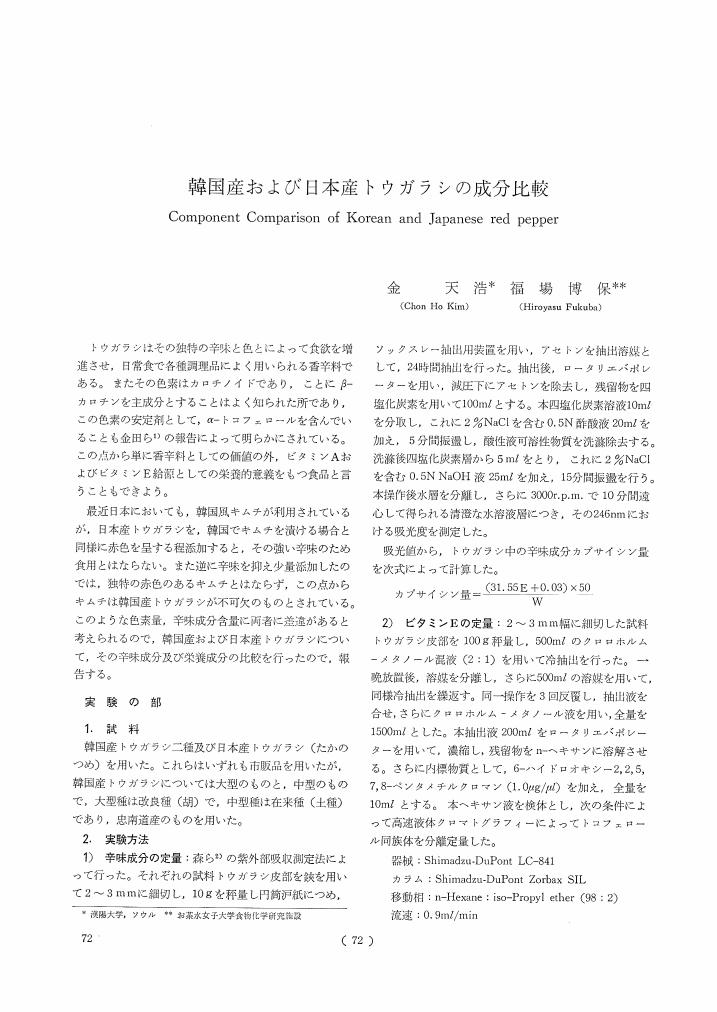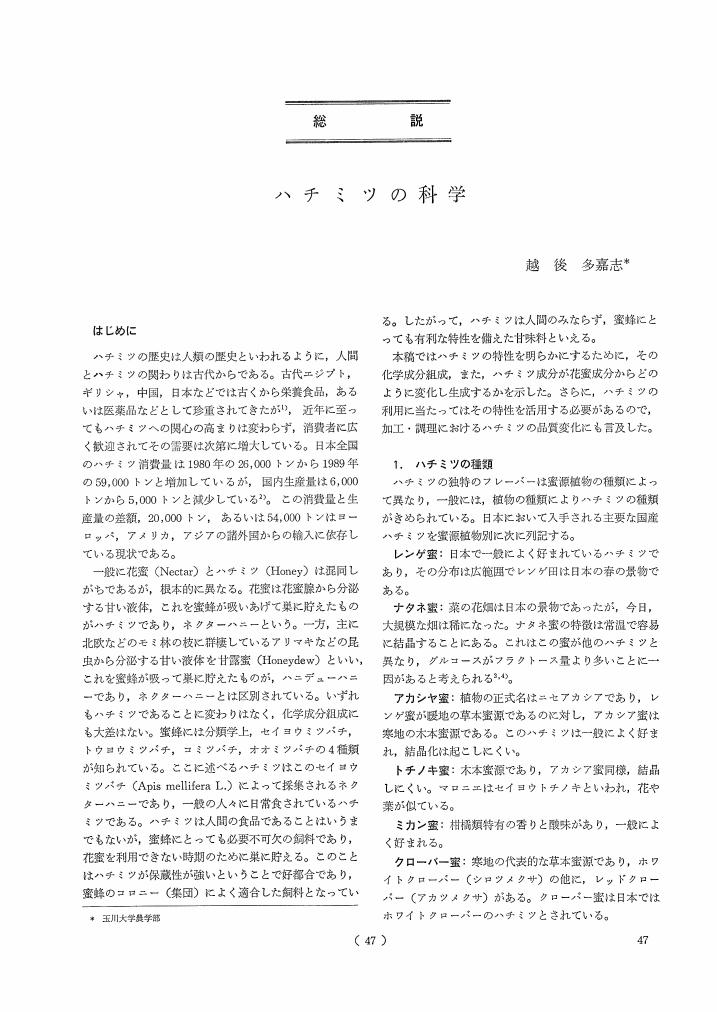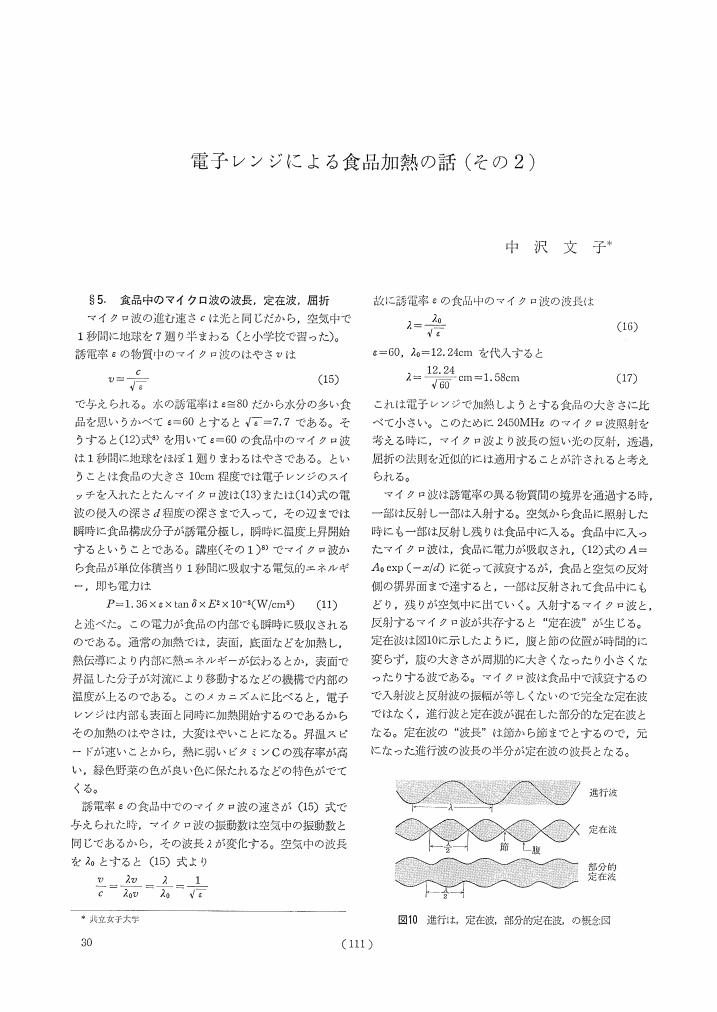7 0 0 0 OA ガスコンロの電子制御と調理温度
- 著者
- 玉川 雅章
- 出版者
- 一般社団法人 日本調理科学会
- 雑誌
- 調理科学 (ISSN:09105360)
- 巻号頁・発行日
- vol.26, no.1, pp.54-62, 1993-02-20 (Released:2013-04-26)
7 0 0 0 OA 韓国産および日本産トウガラシの成分比較
- 著者
- 金 天浩 福場 博保
- 出版者
- 一般社団法人 日本調理科学会
- 雑誌
- 調理科学 (ISSN:09105360)
- 巻号頁・発行日
- vol.13, no.1, pp.72-74, 1980-04-30 (Released:2013-04-26)
- 参考文献数
- 2
7 0 0 0 OA 組織状大豆たん白食品の歩み
7 0 0 0 OA 果実ペクチンの性状とそのゼリー特性について
- 著者
- 川端 晶子
- 出版者
- 一般社団法人日本調理科学会
- 雑誌
- 調理科学 (ISSN:09105360)
- 巻号頁・発行日
- vol.5, no.2, pp.70-79, 1972-06-20
- 被引用文献数
- 1
果実ペクチンの性状と、そのゼリー特性について見当した結果、次のような結論を得た.(1)新鮮果実の総ペクチン含有量は、柑橘類はいずれも高く、金柑のパルプ3.13%、果皮1.84%、柚子のパルプ3.76%、果皮2.96%、仏手柑2.60%であった。梅0.37%、桃0.39%、桜桃0.47%、でいずれも低く、すぐりは0.51%、マルメロ0.75%でやや高い値を示した。(2)分離調整したペクチン質の科学的性状中でとくに、無水ガラクチュロン酸の含有量は、金柑ペクチン64.11%、柚子ペクチン56.57%、仏手柑ペクチン57.12%、梅ペクチン55.44%、桃ペクチン46.42%、桜桃ペクチン54.25%、で無水ウロン酸として、すぐりペクチンは45.72%、マルメロペクチンは48.69%であった。ゲル形成に影響を与えると考えられているメトキシル基含有量は、柑橘類ペクチンは一般に高く、金柑ペクチン13.57%、柚子ペクチン12.73%、仏手柑ペクチン11,41%で、低いほうでは、梅ペクチン9.40%、桜桃ペクチン9.21%であった。(3)糖濃度別S.ペクチンゼリーの特性では、65%糖濃度のものがゼリー強度が最も大であった。酸濃度別S.ペクチンゼリーにおいて,クエン酸濃度0.1%以下では,ゼリーをつくらず,O.2%で最高のゼリー強度を示し,O.4%以上ではゼリー強度がいちじるしく弱められた。各種ベクチンの濃度別ゼリーにおいて,0.25%では液状またはのり状を呈し,S.ペクチンは0.5%以上,R.ペクチンは0.75%以上でゲルを形成するが,L.M.ペクチンでは,1.25%,1.5%ではじめて軟らかいゼリーをつくった。(4)果実ペクチンのOKADA gelometerによるゼリー特性において,調製法別では,いずれの試料においても,Acid in glass法によるものが,ゼリー強度がもっとも大で,破断の際の変形も少なく,α角,β角ともに小さい傾向を示した。Acid in boil法によるものが,それにつづき,Cooking jellyではゼリー強度が小さく,α角,β角ともに大で,やや異なったゼリー特性を示した。試料間では,柑橘類の金柑,仏手柑,および梅,マルメロペクチンがゼリー強度が大で,弾性のあるゼリー特性があると考えられるが,桃および桜桃ペクチンは,上記ベクチンにくらべてゼリー強度がかなり小さい。(5)果実ペクチンのCurdmeterによるゼリー特性においても,Acid in glass法によるものが,もっとも硬く,破断力も大で,Acid in boil法によるものがそれにつづくが,Cooking jellyでは,柔らかく,粘稠性を示すものもあった。試料間では,梅ペクチンがいずれの調製法による場合でも破断力の大きいゼリー特性を示し,金柑,仏手柑ペクチンではCooking jellyのみが粘稠性を示し,柚子,桃,桜桃ペクチンでは,いずれの調製法によるものも,粘稠性を示した。(6)メトキシル基含有量とCurdmeterによる硬さの関連性について,総体的にはいずれも9%以上の高メトキシルペクチンであり,硬さの値が大であったが,桜桃,桃,ペクチンゼリーとAcid in boil法による柚子ペクチンゼリーが,高メトキシルペクチンにもかかわらず,かなり小さい値を示した。水素イオン濃度とゲル化力,分子量の大小とゲル強度およびエステル化率とゲル形成速度などについて,今後検討を加えたい。最後に,本研究に関し終始御懇篤なる御指導をいただきました国学院大学木原芳次郎教授に深謝いたしますとともに実験に御協力下さいました百瀬晴子氏,沢山茂氏,土佐春代氏に感謝申し上げます。
7 0 0 0 無脊椎動物の筋肉構造と構成タンパク質 : イカ・タコを中心として
6 0 0 0 OA ハンバーグステーキ
- 著者
- 三田 コト
- 出版者
- 一般社団法人 日本調理科学会
- 雑誌
- 調理科学 (ISSN:09105360)
- 巻号頁・発行日
- vol.24, no.4, pp.350-353, 1991-11-20 (Released:2013-04-26)
- 参考文献数
- 6
6 0 0 0 OA カット野菜の品質保持研究の現状
- 著者
- 太田 英明 菅原 渉
- 出版者
- 一般社団法人 日本調理科学会
- 雑誌
- 調理科学 (ISSN:09105360)
- 巻号頁・発行日
- vol.19, no.4, pp.242-248, 1986-12-20 (Released:2013-04-26)
- 参考文献数
- 25
6 0 0 0 OA ハチミツの科学
- 著者
- 越後 多嘉志
- 出版者
- 一般社団法人 日本調理科学会
- 雑誌
- 調理科学 (ISSN:09105360)
- 巻号頁・発行日
- vol.26, no.1, pp.47-53, 1993-02-20 (Released:2013-04-26)
- 参考文献数
- 31
- 被引用文献数
- 2
6 0 0 0 OA 高圧加熱による豚の角煮の物性とその皮のタンパク質の動向
卓袱料理の豚の角煮は, 常法では長時間かけて水煮してつくられるので, 高圧加熱による早煮法を検討した。先ず感応検査でほぼ同じやわらかさの角煮を得るための高圧加熱時間を求め, その角煮について物性, 脂肪含量および組織の相違を調べた。また一般家庭では豚皮はかたいので除去されるが, 高圧加熱した場合の嗜好や軟化に関係するタンパク質の動向を電気泳動で調べ, 消化率も求めて利用価値を検討した。1) 40分間高圧加熱後, 水を換えて再び20分間加熱した角煮(S3)は, 常法の4時間水煮(S1)とほぼ同じやわらかさの製品が得られた。機器による物性測定でも, ほぼ同じ性質をもつものであることを示した。2) 高圧加熱されたS3は, S1に比べて重量と脂肪含量は僅かに低値を示した。またガス消費量と調理所要時間は, 常法の45%と25%であった。3) S3の皮部の可溶性コラーゲン量は, S1の皮部とほぼ同量であり, また両者の可溶性タンパク質の電気泳動パターンもほぼ同じであった。4) 高圧加熱によると, 豚皮は短時間にゼラチン化し, 製品の口あたりをよくし, 消化率も高く, 利用価値が認められた。5) 組織は, S3の皮部のコラーゲン線維がほぐれて細分化し, さらに一部溶解していた。これが物性を口あたりよいやわらかさに変えた。肉部では結締組織が顆粒化し内筋周膜の間隙にも顆粒が充満し, これがもろさの原因と思われた。
6 0 0 0 OA かまぼこの話
- 著者
- 志水 寛
- 出版者
- 一般社団法人 日本調理科学会
- 雑誌
- 調理科学 (ISSN:09105360)
- 巻号頁・発行日
- vol.24, no.4, pp.322-328, 1991-11-20 (Released:2013-04-26)
- 参考文献数
- 15
5 0 0 0 OA 炊飯とでんぷんの老化
- 著者
- 檜作 進
- 出版者
- 一般社団法人 日本調理科学会
- 雑誌
- 調理科学 (ISSN:09105360)
- 巻号頁・発行日
- vol.3, no.4, pp.225-229, 1970-12-20 (Released:2013-04-26)
- 参考文献数
- 18
- 被引用文献数
- 7
5 0 0 0 OA 近代の食卓をめぐる文化
- 著者
- 熊倉 功夫
- 出版者
- 一般社団法人 日本調理科学会
- 雑誌
- 調理科学 (ISSN:09105360)
- 巻号頁・発行日
- vol.26, no.2, pp.149-154, 1993-05-20 (Released:2013-04-26)
5 0 0 0 OA こんぶの等級とだし汁の成分の関係
- 著者
- 松本 仲子 甲田 道子 菅原 龍幸
- 出版者
- 一般社団法人 日本調理科学会
- 雑誌
- 調理科学 (ISSN:09105360)
- 巻号頁・発行日
- vol.24, no.3, pp.204-208, 1991-08-20 (Released:2013-04-26)
- 参考文献数
- 7
- 被引用文献数
- 3
The analysis of the components of the first-class, second-class and third-class Rishiri-konbu and the first-class Ma-konbu and the sensory evaluation of Dashi prepared from these konbu were conducted to investigate the relation between the classes of konbu and the components/liking of Konbu Dashi. The results were as follows.1. In Rishiri-konbu, the upper-class one was high in the contents of protein, free glutamic acid, free aspartic acid etc. as compared with the lower-class one. Further, the first-class Ma-konbu was high in the content of these components as compared with the first-class Rishiri-konbu.2. No component difference was found among the Dashi of the first-class, second-class and thirdclass Rishiri-konbu. However Ma-konku Dashi was much in the elution quantity of palatable components as compared with Rishiri-konbu Dashi.3. Difference in the elution rate of glutamic acid was not found among these Risuiri-konbu Dashi.4. No significant correlation was found between the overall impression score of Dashi at the sensofy test and the class in a ranking. The score of Dashi prepared at 10-100°C for5 minutes became smaller in the order of first-class, second-class and third-class, but the score of Dashi prepared at 100°C for 5 minutes became in the revefse order. 5. As an effective method for the preparation of third-class Konbu-Dashi, it was advisable to heat the lconbu in boiling water for a sufficient elution of palatable components.
5 0 0 0 OA たけのこ料理と京都
- 著者
- 口羽 章子 坂本 裕子
- 出版者
- 一般社団法人日本調理科学会
- 雑誌
- 調理科学 (ISSN:09105360)
- 巻号頁・発行日
- vol.23, no.3, pp.263-266, 1990-08-20
5 0 0 0 OA インドネシア(ジャワ島)の味
5 0 0 0 OA 醸造食品の肉の物性に対する調理効果(1)酒類について
- 著者
- 奥田 和子 上田 隆蔵
- 出版者
- 一般社団法人 日本調理科学会
- 雑誌
- 調理科学 (ISSN:09105360)
- 巻号頁・発行日
- vol.23, no.4, pp.326-335, 1990-11-20 (Released:2013-04-26)
- 参考文献数
- 5
- 被引用文献数
- 3
5 0 0 0 OA 電子レンジによる食品加熱の話(その2)
- 著者
- 中沢 文子
- 出版者
- 一般社団法人 日本調理科学会
- 雑誌
- 調理科学 (ISSN:09105360)
- 巻号頁・発行日
- vol.20, no.2, pp.111-117, 1987-07-20 (Released:2013-04-26)
- 参考文献数
- 3
- 被引用文献数
- 2
5 0 0 0 OA 小豆あんの研究
- 著者
- 畑井 朝子
- 出版者
- 一般社団法人 日本調理科学会
- 雑誌
- 調理科学 (ISSN:09105360)
- 巻号頁・発行日
- vol.13, no.2, pp.97-105, 1980-07-30 (Released:2013-04-26)
- 参考文献数
- 12
- 被引用文献数
- 1
5 0 0 0 OA マーマレード作製中のナリンギン量の変化について
- 著者
- 諸星 俊雄 菅原 龍幸
- 出版者
- 一般社団法人日本調理科学会
- 雑誌
- 調理科学 (ISSN:09105360)
- 巻号頁・発行日
- vol.4, no.2, pp.116-118, 1971-06-20
マーマレード作製における苦味処理過程中のナリンギン量の変化を調べた。(1)外果皮は2〜3時問水晒しすることにより80〜85%のナリンギンが除去され,3時間以後はほぼ一定の値を示した。内白部,ひょうのうは2〜3時間の水晒しで60〜70%のナリンギンが除去され3時間以後は,ほぼ一定の値を示した。(2)マーマレード作製において苦味処理を2%食塩水で30分湯煮後,1時問水晒しするか,または45〜60分湯煮し水晒しを行なわない条件でも,従来の一般的作製法にみられる苦味処理を長時間行なって作製した製品と苦味,果皮の硬さ,総合などの点で変らぬものができた。おわりに試料入手に御協力していただいた向笠進氏ならびに本実験に御協力していただいた川野和子,木村澄子,室橋晶子さんに感謝いたします。
5 0 0 0 OA 食品中のビタミンCの安定性に関する基礎的検討
- 著者
- 林 宏子
- 出版者
- 一般社団法人 日本調理科学会
- 雑誌
- 調理科学 (ISSN:09105360)
- 巻号頁・発行日
- vol.26, no.1, pp.12-26, 1993-02-20 (Released:2013-04-26)
- 参考文献数
- 22
- 被引用文献数
- 1 6
The conditions of quantitative analysis of vitamin C in foods by Fujita's method of thin layer chromatography were investigated and the following improvements were made.1) The drying step of ethylacetate dissolving osazon can be omitted.2) The thin layer after development is able to be left alone for 2 days before starting the next step.3) The fraction of vitamin C can be dissolved with 50% sulfuric acid without any trouble.4) Silica gel should be removed by the use of a glass filter.The amount of vitamin C in foods was determined by subtracting the amount of diketoglonic acid which was estimated from the remaining amount following reduction of an aliquot portion of the test sample according to Tamura's method from the amount of vitamin C determined by this modified method.The remaining amounts of vitamin C in some fruits and vegetables such as broccoli, were determined under various cooking conditions; without heating, heating at 100°C pH-changing etc. From the present results, it was demonstrated that the amount of vitamin C in foods including ascorbinase varies considerably and vitamin C tends to be short of stability at cooking.













